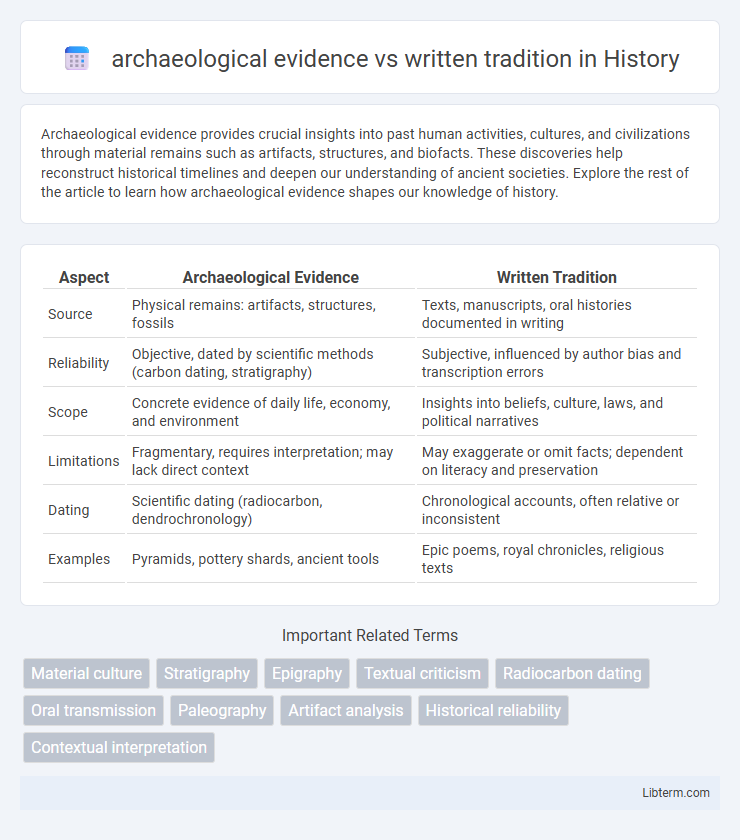Archaeological evidence provides crucial insights into past human activities, cultures, and civilizations through material remains such as artifacts, structures, and biofacts. These discoveries help reconstruct historical timelines and deepen our understanding of ancient societies. Explore the rest of the article to learn how archaeological evidence shapes our knowledge of history.
Table of Comparison
| Aspect | Archaeological Evidence | Written Tradition |
|---|---|---|
| Source | Physical remains: artifacts, structures, fossils | Texts, manuscripts, oral histories documented in writing |
| Reliability | Objective, dated by scientific methods (carbon dating, stratigraphy) | Subjective, influenced by author bias and transcription errors |
| Scope | Concrete evidence of daily life, economy, and environment | Insights into beliefs, culture, laws, and political narratives |
| Limitations | Fragmentary, requires interpretation; may lack direct context | May exaggerate or omit facts; dependent on literacy and preservation |
| Dating | Scientific dating (radiocarbon, dendrochronology) | Chronological accounts, often relative or inconsistent |
| Examples | Pyramids, pottery shards, ancient tools | Epic poems, royal chronicles, religious texts |
Introduction to Archaeological Evidence and Written Tradition
Archaeological evidence provides material remains such as artifacts, structures, and ecofacts that offer tangible insights into past human activities and cultures. Written tradition, on the other hand, consists of documented records like manuscripts, inscriptions, and oral histories that convey historical narratives and cultural knowledge. Comparing these sources helps reconstruct a more comprehensive understanding of history by validating or challenging textual accounts with physical data.
Defining Archaeological Evidence
Archaeological evidence consists of physical artifacts, structures, and organic remains excavated from historical sites that provide tangible proof of past human activities and cultures. Unlike written tradition, which relies on recorded texts and oral histories that may be influenced by subjective interpretations, archaeological data offers direct material insights into ancient societies. This evidence allows researchers to reconstruct historical contexts and verify or challenge narratives found in historical documents.
Understanding Written Traditions
Written traditions offer invaluable insights into past cultures by preserving narratives, laws, and beliefs that archaeological evidence alone cannot fully reveal. These textual sources provide context to material findings, enabling researchers to reconstruct historical events, social structures, and ideological frameworks more comprehensively. Examining written traditions alongside artifacts enhances the accuracy and depth of historical interpretation.
Strengths and Limitations of Archaeological Evidence
Archaeological evidence provides tangible artifacts and physical contexts that can be scientifically dated, offering objective insights into past cultures and societies often absent in written traditions. Its strength lies in revealing everyday life, technology, and material culture that written records might overlook or omit due to bias or literacy limitations. However, archaeological data can be fragmentary and open to interpretation, as site degradation, incomplete remains, and the absence of explicit narratives restrict the ability to fully reconstruct historical events or intentions.
Reliability and Bias in Written Records
Written records often contain biases shaped by the author's perspective, political agenda, or cultural context, impacting their reliability as historical sources. Archaeological evidence provides tangible, physical data that can either corroborate or challenge narratives found in written texts, offering an independent line of inquiry. Combining both sources enables a more balanced and comprehensive understanding of past events, mitigating the limitations inherent in relying solely on written tradition.
When Archaeology Confirms Tradition
Archaeological evidence often confirms written tradition by substantiating historical events, places, and cultural practices described in ancient texts. Excavations revealing artifacts, inscriptions, or city ruins provide tangible proof that validates the accuracy of written records from civilizations such as the Egyptians, Greeks, and Mesopotamians. This convergence of material findings and textual accounts strengthens the credibility of historical narratives and enriches our understanding of past societies.
Cases of Contradiction: Evidence vs. Texts
Archaeological evidence sometimes contradicts written tradition by revealing discrepancies in timelines, material culture, or event details documented in historical texts. For example, excavations at ancient sites like Troy and Jericho have challenged the biblical narrative by showing destruction layers that do not align with scriptural chronologies. Such cases highlight the importance of integrating stratigraphic data, carbon dating, and artifact analysis to reassess and refine historical understanding beyond textual claims.
Interpreting Gaps and Silences
Archaeological evidence reveals material culture and environmental contexts often absent from written tradition, enabling reconstruction of societies with limited or biased texts. Interpreting gaps and silences demands critical analysis of both tangible artifacts and surviving manuscripts to address historical omissions and cultural marginalization. Integrating stratigraphy, radiocarbon dating, and epigraphic studies enhances understanding of periods where textual records are sparse or contradictory.
The Role of Modern Technology in Analysis
Modern technology plays a crucial role in analyzing archaeological evidence by enabling precise dating techniques such as radiocarbon dating and advanced imaging methods like ground-penetrating radar and 3D scanning. These technologies allow researchers to uncover and interpret artifacts with greater accuracy, often revealing details that written traditions alone cannot provide. The integration of digital databases and AI-driven pattern recognition facilitates cross-referencing between material finds and historical texts, enhancing the overall understanding of past civilizations.
Toward an Integrated Historical Narrative
Archaeological evidence provides tangible artifacts and stratigraphic data that anchor historical timelines, while written tradition offers contextual narratives and cultural perspectives. Combining these sources enables a more nuanced reconstruction of past events by corroborating material findings with textual descriptions. This integrated approach enhances accuracy in historical interpretation, bridging gaps between empirical data and literary accounts.
archaeological evidence Infographic

 libterm.com
libterm.com